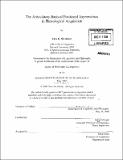The articulatory basis of positional asymmetries in phonological acquisition
Author(s)
McAllister, Tara Kathleen
DownloadFull printable version (40.76Mb)
Other Contributors
Massachusetts Institute of Technology. Dept. of Linguistics and Philosophy.
Advisor
Adam Albright.
Terms of use
Metadata
Show full item recordAbstract
Child phonological processes that lack counterparts in adult phonological typology have long posed a problem for formal modeling of phonological acquisition. This dissertation investigates child-specific processes with a focus on the phenomenon of neutralization in strong position, whereby children preferentially neutralize phonemic contrast in precisely those contexts seen to support maximal contrast in adult systems. These processes are difficult to model without making incorrect predictions for adult typology. Here, it is argued that all genuinely child-specific processes are driven by constraints rooted in child-specific phonetic factors. In a phonetically-based approach to phonology, if there are areas of divergence in phonetic pressures across immature and mature systems, differences across child and adult phonologies are predicted rather than problematic. The phonetically-based approach also explains the developmental elimination of child-specific processes, since in the course of typical maturation, the phonetic pressures driving these effects will cease to apply. Because children's speech-motor control capabilities are known to diverge from those of the skilled adult speaker, it is posited that articulatory factors play the dominant role in shaping child-specific phonological processes. Here it is argued that children have difficulty executing discrete movements of individual articulators, notably the tongue. By moving the tongue-jaw complex as a single unit, the child speaker can reduce the number of degrees of movement freedom and also rely on the action of the motorically simpler mandible to achieve articulatory targets. (cont.) The effects of mandibular dominance have previously been argued to play a role in shaping sound patterns in babbling and early words (MacNeilage & Davis, 1990). The preference for jaw-dominated movement can be seen to recede over time as the child establishes more reliable articulatory control. However, here evidence from the productions of older children is presented indicating that these effects continue to have an influence in later stages of development than has been previously documented. The pressure to use simultaneous movements of the tongue-jaw complex, formalized in a constraint MOVE-AS-UNIT, is argued to play a role in shaping child-specific processes including positional velar fronting, prevocalic fricative gliding, and consonant harmony. In the present approach, children's tendency to neutralize contrast in strong positions arises as MOVE-AS-UNIT interacts with asymmetries in the force and duration of articulatory gestures across different prosodic contexts. The incorporation of child-specific phonetic factors makes it possible to account for complex patterns of conditioning in child speech processes that would under other assumptions be extremely challenging to model.
Description
Thesis (Ph. D.)--Massachusetts Institute of Technology, Dept. of Linguistics and Philosophy, 2009. Cataloged from PDF version of thesis. Includes bibliographical references (p. 250-276).
Date issued
2009Department
Massachusetts Institute of Technology. Department of Linguistics and PhilosophyPublisher
Massachusetts Institute of Technology
Keywords
Linguistics and Philosophy.